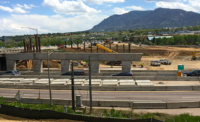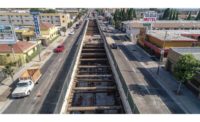P3s, Design-Build Key to L.A. Projects
The widening of I-405 marks one of the few major design-build projects in Los Angeles to date. But thanks to an ambitious initiative to build 12 major transit projects by 2019, rather than over three decades, alternative project delivery methods are expected to be deployed on some of the county's biggest rail and highway projects.
One of the highway projects that might benefit is the decades-old Interstate I-710 completion. “This project has the most promising P3 potential,” said Doug Failing, executive director of highway programs for the Los Angeles Metropolitan Transportation Authority, or L.A. Metro. His remarks came during a May conference of the International Chinese Transportation Professionals Association.
Although L.A. Metro is primarily a builder of transit systems, it also has $8 billion in its $40- billion program allocated for highways.
That $40 billion is the result of a ballot measure passed in 2008. Los Angeles County voters approved Measure R, a half-cent sales-tax increase. Then Los Angeles Mayor Antonio Villagaroisa (D) introduced the so-called 30/10 Initiative to accelerate the projects.
The L.A. Metro board adopted a policy to combine long-term county sales-tax revenue from Measure R with alternative project delivery and financing methods for highway projects. That strategy includes exploring the use of public-private partnerships (P3s) to accelerate delivery of highway projects.
One such project would be the extension of the 23-mile, north-south I-710 route, which is a key artery for trucks driving to and from the ports of Los Angeles and Long Beach. But the last 4.5 miles, meant to reach the city of Pasadena, have been stymied for years due to community opposition.
According to Failing, the state has permission to take the project through the environmental process. A request for proposals for the project has been released.
URS Corp. is preparing the final environmental impact statement for another I-710 project that would widen existing lanes and add a four-lane freight corridor. “There is a huge tolling possibility and potential for P3s,” says Failing.
Another candidate for a P3 will be the High Desert Corridor, a planned 55-mile greenfield highway connecting Los Angeles to San Bernadino County. Environmental analysis is expected to be complete in 2013.
On the transit side, L.A. Metro expects a $1.75-billion light-rail line to receive final environmental clearance this year. Failing said the agency will conduct industry outreach to determine if it will be built using design-build.
Design-build isn't a surefire method. Rick Thorpe, CEO for the Exposition Line light-rail project, tried “negotiated design-build” on the first phase of the $640-billion program, now more than $800 billion, which began in 2006. “Rather than getting fixed prices, we had [the Flatiron-Fluor-Parsons joint venture] do preliminary engineering and take design to the 85% level, then negotiated the construction packages,” he says. But unexpected system additions and issues with local agencies bogged down design, he says. The first phase is a year behind its 2010 slated completion.
For the second phase, he says, “we hired the two best contractors we could find and gave them each half the preliminary engineering funds.” Five teams competed for the opportunity, and two were chosen. The teams then came up with firm fixed prices and made best and final offers,” says Thorpe. A team led by Skanska and Steve P. Rados Inc. won the $542-million contract in March.
But moving forward on future design-build and P3 projects depend largely on whether Metro can obtain an an overall $1.7 billion grant, and legislation for transit improvement bonds and federal credit assistance. The funds would accelerate construction, and Metro would then pay Washington back for 20 more years with Measure R revenues.





